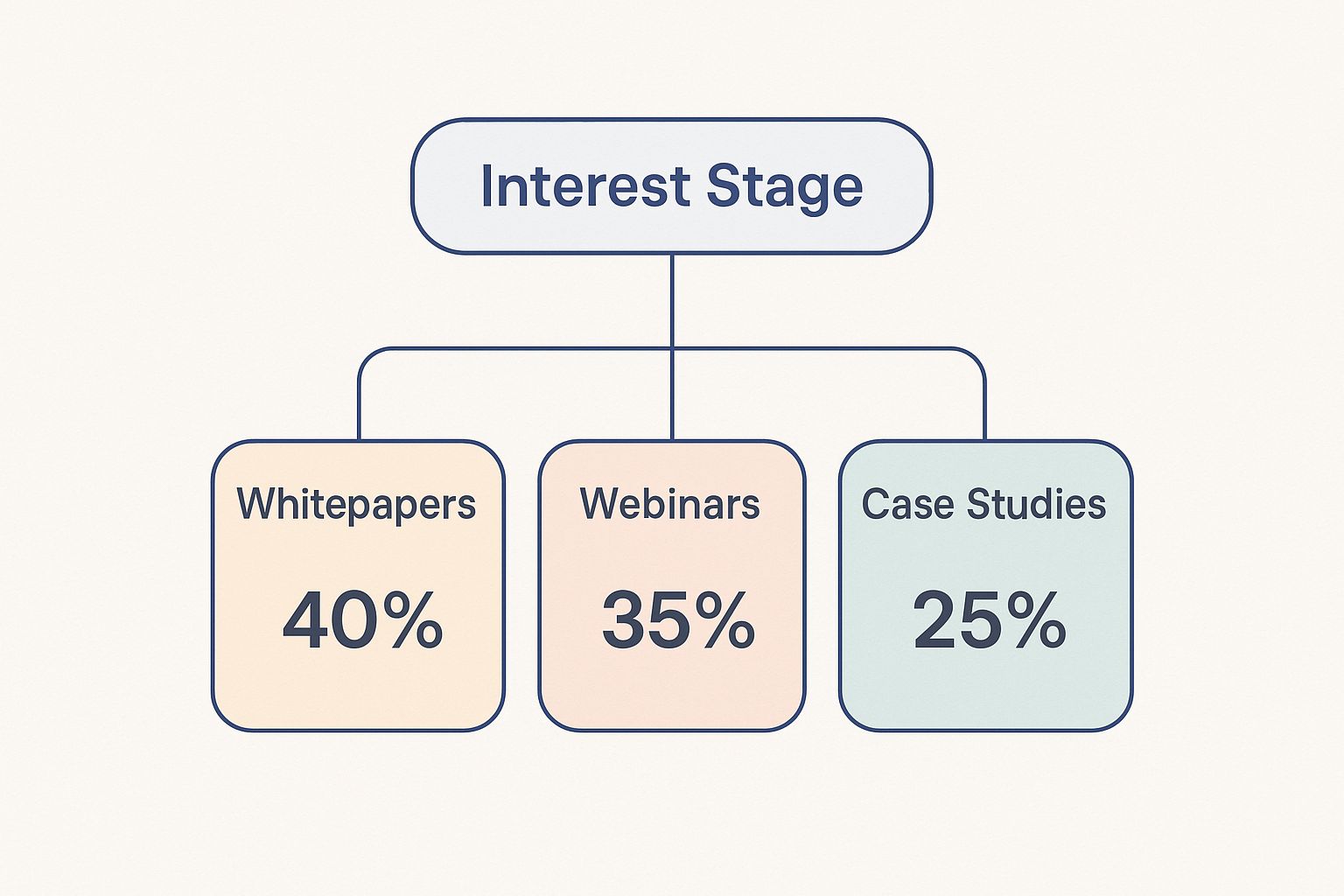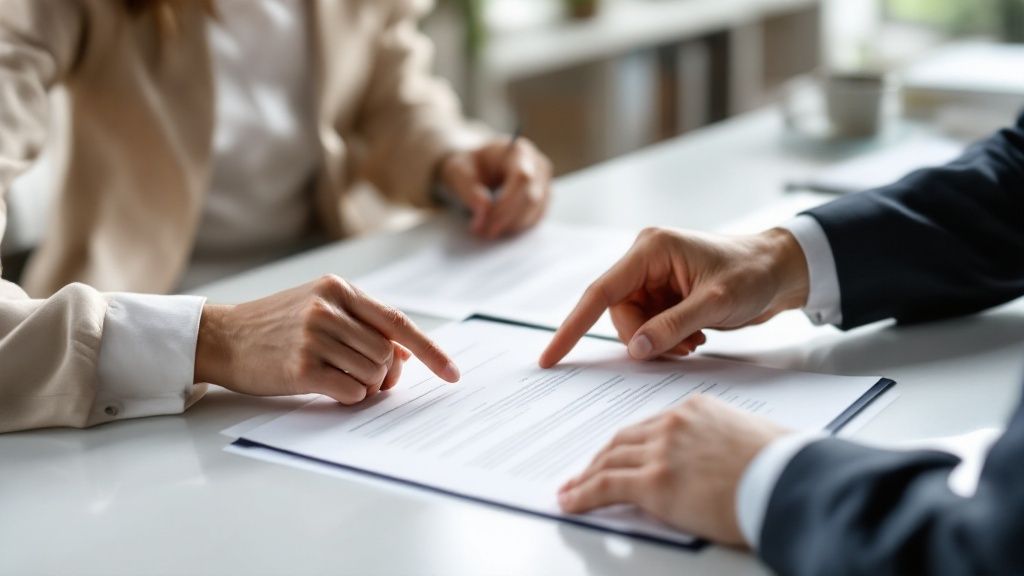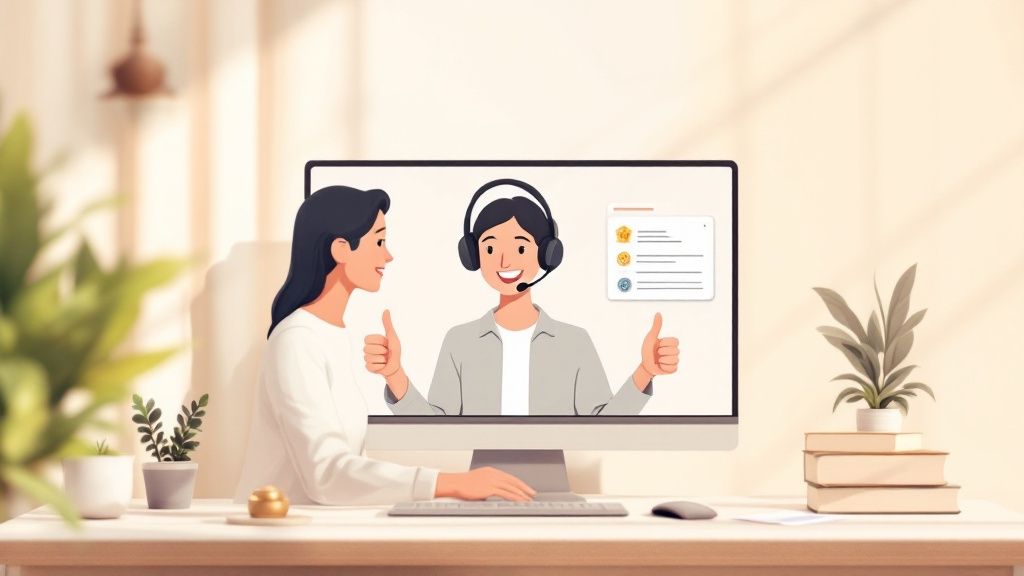Master the Customer Journey Funnel for Better Conversions
Learn how to optimize your customer journey funnel with actionable strategies to boost conversions and drive growth. Discover the key steps today!
A practical guide to the B2B sales funnel. Learn to build, measure, and optimize your funnel with proven strategies for converting leads into customers.
TL;DR
A B2B sales funnel is your roadmap for guiding prospects from awareness to purchase. Mastering this framework helps you pinpoint weak spots in your process, optimize every stage, and build a predictable engine for revenue growth.
A B2B sales funnel is a visual roadmap detailing the journey a potential customer takes, from their first interaction with your brand to becoming a paying client. Unlike a simple transaction, B2B sales involve long cycles and multiple decision-makers, making a structured process essential. This framework helps you understand and guide prospects through each stage of their buying decision.

Think of the B2B sales funnel as the blueprint for your entire sales and marketing strategy. It’s not an abstract theory; it’s a hands-on tool that gives you a clear, structured way to guide high-value prospects through what is often a long and complicated buying journey.
Because B2B sales cycles often drag on for months and require buy-in from multiple stakeholders, a defined funnel isn't just nice to have—it's non-negotiable. It turns a potentially chaotic, unpredictable process into a manageable, repeatable system.
A well-defined funnel acts as a diagnostic tool for your whole sales motion. By tracking how prospects move from one stage to the next, you can pinpoint exactly where deals are stalling or falling through the cracks. This data-driven approach is the secret to generating predictable, scalable revenue.
This framework is critical for any business navigating:
Think of your B2B sales funnel as a journey. At the top, you have a crowd of people who might have a problem your business can solve. As they move down, that crowd thins out and the conversations get more serious. By the end, you’re left with the prospects who are the best fit to become your next great customers.
Each stage requires a different approach because the prospect is thinking differently. We break this down into three core phases: Top of Funnel (TOFU), Middle of Funnel (MOFU), and Bottom of Funnel (BOFU). Understanding these stages isn’t just academic—it’s how you spot leaks in your process and systematically improve your results.
The top of the funnel is all about attraction and education, not selling. Prospects here are problem-aware but not yet solution-aware. They’re thinking, "Why is our team's productivity so low?" or "What new trends are affecting my industry?" They're looking for answers and insights, not product pitches.
Your job is to be the expert they find. This is where marketing takes the lead, focusing on activities that offer value with no strings attached:
The goal here is to generate Marketing Qualified Leads (MQLs)—people who have shown interest by downloading an ebook or subscribing to your newsletter.
Once someone enters the middle of the funnel, the game changes. They've put a name to their problem and are now actively researching solutions. Your goal shifts to building trust and demonstrating value.
The prospect’s mindset is now more analytical. They’re comparing vendors, weighing different approaches, and trying to figure out who can actually solve their problem. They're asking, "Which of these options is the right fit?" and "Who is a credible partner?"
This is the crucial handoff from marketing to sales, where leads are nurtured and qualified. Your activities become more targeted, designed to prove your expertise and show what makes your solution different. As you refine this process, you can explore how different sales pipeline stages map to your funnel's unique shape.
Key MOFU activities include:
The data below shows what kind of content resonates at this stage.

As you can see, prospects are looking for substance. In-depth content like whitepapers and case studies are king because they provide the proof buyers need to move forward.
The main objective here is to convert those MQLs into Sales Qualified Leads (SQLs)—leads that sales and marketing agree are ready for a real sales conversation.
Welcome to the final stretch. At the bottom of the funnel, your prospect has done their homework, weighed their options, and narrowed it down to a shortlist. Your goal is simple: close the deal.
The mindset here is all about the purchase. They’re hashing out the final details—pricing, implementation, contracts. The big question on their mind is, "Is this the right partner for us, and what will it take to get started?"
This is where your sales team shines. The conversation moves from education to a specific solution for their business. It’s all about proving how your product delivers a tangible return on their investment.
A critical mistake here is to fall back into a generic pitch. The BOFU conversation must be intensely personal, tailored to the specific pain points, goals, and stakeholders you've uncovered throughout the entire funnel.
Activities at the bottom of the funnel are laser-focused on getting the contract signed:
Success in the BOFU stage is measured by one thing: turning an SQL into a paying customer.
| Funnel Stage | Prospect Mindset | Key Activities | Primary Goal |
|---|---|---|---|
| TOFU | "I have a problem, but I'm not sure what to do about it." | Content marketing, SEO, social media, educational webinars. | Generate Marketing Qualified Leads (MQLs). |
| MOFU | "I'm researching solutions and comparing my options." | Case studies, whitepapers, product demos, lead nurturing. | Convert MQLs into Sales Qualified Leads (SQLs). |
| BOFU | "I'm ready to make a decision and choose a partner." | Customized proposals, free trials, contract negotiation, final demos. | Convert SQLs into new customers. |
This table provides a clear roadmap. By aligning your team's actions with the prospect's mindset at each step, you build a much more effective and predictable sales process.
Running a B2B sales funnel without data is like driving with no dashboard. You're moving, but you have no idea if you're about to run out of gas. Measuring your funnel's health turns guesswork into a predictable, data-driven way to generate revenue. You can finally stop guessing where things are broken and start knowing.
Instead of drowning in vanity metrics, let's zero in on the key performance indicators (KPIs) that tell the true story of your funnel's performance. These are the numbers that expose bottlenecks, shine a light on opportunities, and let you forecast revenue with confidence.
To understand what's working, you have to look beyond just the total number of leads. The real insights come from tracking how efficiently prospects move from one stage to the next.
Here are three essential metrics to get started:
Keeping an eye on these core numbers gives you a quick, accurate snapshot of your funnel’s health.
Knowing your own conversion rates is only half the battle. The real power comes from comparing your performance against industry benchmarks. This context helps you set realistic goals and figure out which "leaks" are normal and which are critical.
Industry benchmarks show that conversion rates vary wildly by stage. At the top of the funnel, only about 1-3% of prospects might become leads. This rate jumps to around 10-15% in the middle as leads become qualified opportunities. By the bottom, you can expect conversion rates of 20-30% from opportunity to closed deal.
If your MQL-to-SQL conversion rate is only 2% while the industry average is 10%, you don’t just have a leak; you have a major problem with either your lead qualification criteria or your nurturing process.
Using these benchmarks, you can audit your funnel systematically. A steep drop-off between any two stages tells you exactly where to focus your energy.
Once you have the basics down, you can add more nuanced metrics for a complete picture of your funnel's financial health. These KPIs link your funnel's performance directly to business outcomes.
For a more detailed look at the numbers that drive growth, check out our guide on lead generation key performance indicators. To assess your funnel's current state, a resource like a SaaS funnel audit checklist can be incredibly helpful. By tracking these vital signs, you transform your sales funnel from a simple model into a powerful engine for predictable growth.

It’s easy to think there’s a single, universal B2B sales funnel. The reality? The size of your company—and the companies you sell to—completely changes the game. Strategies that work for a nimble startup often fall flat in a massive enterprise, and vice versa.
Getting this right is crucial. A startup selling to other small businesses is playing a totally different sport than a corporation selling to the Fortune 500.
Smaller companies usually have an advantage at the top of the funnel. Their agility allows for incredibly targeted and personal outreach, which often translates into higher initial engagement. They can build real relationships without getting tangled in corporate red tape.
But this advantage can flip as deals move toward the finish line. Small businesses have to constantly fight for brand recognition and trust. A prospect might love the product, but a lack of a big-name reputation can cause hesitation when it’s time to sign a high-value contract.
Plus, small businesses typically have smaller sales teams where one person juggles prospecting, nurturing, and closing, which can stretch resources thin.
For large enterprise corporations, the story is often the opposite. Their established brand is a powerful magnet for leads, but broad marketing efforts can lead to lower conversion rates at the top of the funnel. It’s a classic case of quantity over quality.
The real challenge for enterprise teams is the middle and bottom of the funnel. Sales cycles are notoriously long, often stretching over a year as deals pass through legal, procurement, and finance. You’re not just selling to one person; you’re selling to a complex buying committee with competing priorities.
In the enterprise world, a successful B2B sales funnel isn’t about a single transaction. It's about orchestrating consensus among a diverse group of stakeholders, each with their own unique pains and objectives.
To win, enterprise sales teams must master multi-threading—building solid relationships with multiple key players inside the target account. This is where deep strategic planning is essential. You can sharpen your team's approach by diving into best practices for strategic account planning.
The performance benchmarks between these two worlds are starkly different.
Small to mid-sized companies ($10 million - $100 million in revenue) see a Visitor-to-Lead conversion rate of about 1.4%, which then jumps to a healthy 41% from Lead to Marketing Qualified Lead (MQL).
Compare that to enterprise firms (over $1 billion in revenue). Their initial Visitor-to-Lead rate is only 0.7%, and their downstream conversions are generally lower, like the 31% from Opportunity to Close.
The data is clear: enterprise funnels are often wider at the top but leak more at every stage due to their complexity. Smaller businesses have narrower, more efficient funnels at the start but have to work harder to build the trust needed to close deals.

Knowing what a B2B sales funnel is is one thing. Optimizing it is how you build a predictable revenue engine. You need a playbook of concrete tactics to plug leaks, speed up deals, and boost performance at every stage.
Let's break down practical strategies you can use to strengthen each part of your funnel, from the first touchpoint to the final handshake.
The goal at the top of the funnel is to attract the right audience, not just any audience. Generic content casts a wide net but catches few qualified fish. The key is precision and value.
Get specific with your SEO strategy. Focus on the long-tail, intent-driven phrases your ideal customers are actually typing into Google. Think "supply chain management software for mid-sized retailers" instead of just "logistics software."
From there, create "pillar pages" or comprehensive guides on the core topics your audience obsesses over. This builds authority with both search engines and potential buyers, pulling in high-quality organic traffic. Your content should solve real problems, positioning your brand as a helpful expert from the start.
Once you've grabbed a lead's interest, the middle of the funnel is about building trust and showing undeniable value. This is where most funnels spring their biggest leaks. Your best tools here are automation and high-value content.
Set up lead nurturing sequences that deliver the right content at the right time. For example, if a lead downloads a whitepaper on improving manufacturing efficiency, your automated follow-up should offer a case study showing how you helped a similar company do exactly that.
The MOFU stage isn't about pushing for a demo. It's about earning the right to ask for one by consistently proving you understand the prospect's world and have credible solutions for their challenges.
This is also the perfect time to get your sales and marketing teams aligned. For a deeper dive into creating that synergy, check out these essential RevOps best practices. To make your team even more efficient, you should also implement sales funnel automation to handle repetitive tasks.
At the bottom of the funnel, the conversation shifts from broad education to specific, tailored solutions. Your sales team needs the right sales enablement resources to deliver knockout demos, navigate tricky negotiations, and make the path to purchase as smooth as possible.
Arm your reps with battle cards that highlight your competitive advantages and customizable demo scripts that speak directly to a prospect's stated pain points. A generic demo is a deal-killer. A great demo makes the prospect feel like you built the solution just for them.
The quality of your sales calls is everything at this stage. A meta-analysis across 25 industries found that average sales call conversion rates hover between 13% and 25%. Unsurprisingly, price plays a big role; deals under $10,000 close around 25.73% of the time, while massive deals over $5 million drop to about 9.09%. Even more telling, referrals are the king of conversions at 25.56%, while cold calls lag way behind at 9.38%.
This data gives us two critical takeaways for BOFU optimization:
By applying these targeted strategies to each stage of your B2B sales funnel, you can methodically improve your entire process and drive more revenue.
The key differences are complexity and sales cycle length. B2B funnels are designed for long, multi-stakeholder sales driven by logic and ROI. B2C funnels are for shorter, individual purchasing decisions that are often influenced by emotion and brand appeal.
Track your stage-by-stage conversion rates. A significant drop-off between any two stages (e.g., from MQL to SQL) is a "leak." Comparing your numbers to industry benchmarks will tell you exactly where your process is breaking down and needs attention.
Both. It's a shared responsibility. Typically, marketing owns the Top of Funnel (TOFU) and Middle of Funnel (MOFU), focusing on awareness and lead nurturing. Sales owns the Bottom of Funnel (BOFU), where they engage qualified leads and close deals. Tight alignment between the two is essential for success.
Review your key funnel metrics monthly to spot any immediate issues. Conduct a deeper, more strategic review quarterly to analyze trends, assess the impact of your optimizations, and plan for the next quarter.
Ready to stop guessing and start knowing what’s happening inside your target accounts? Salesmotion uses AI to monitor real-time signals across every company on your list, turning raw data into actionable insights that fuel your B2B sales funnel. Discover how you can save 8+ hours per week and increase pipeline by 40%.
Learn how to optimize your customer journey funnel with actionable strategies to boost conversions and drive growth. Discover the key steps today!
Build a winning go to market strategy framework. This guide breaks down the core components, steps, and metrics for a successful product launch.
Unlock predictable revenue by mastering pipeline velocity. Learn the formula, key levers, and proven strategies to accelerate your sales cycle and...